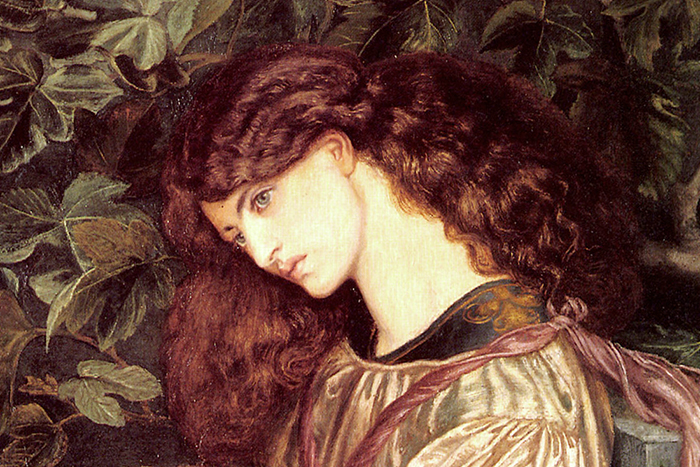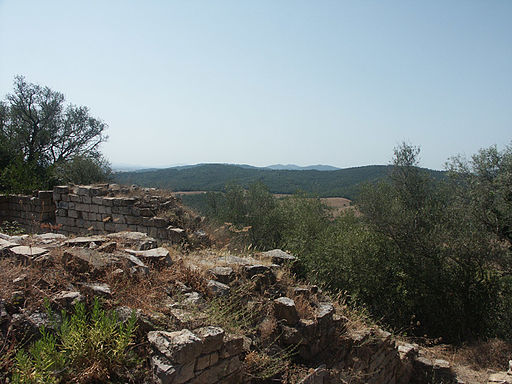| N E D | Dante Gabriel Rossetti, Pia de' Tolomei (1868–1880) (model: Jane Morris), Spencer Museum of Art, University of Kansas, Lawrence, KS, USA
|
Dante Gabriel Rossetti, Pia de' Tolomei (1868–1880) |
Podere Santa Pia was named after Pia de' Tolomei, a woman with an intriguing story. According to some legends, the beautiful Pia di Tolomei, the sorrowful wife of Nello d'Inghiramo de Pannocchieschi, crossed the Ponte della Pia to go into exile in Maremma, at Castello della Pietra. There her husband ordered her execution so he could marry his mistress Margherita Aldobrandeschi, Contessa of Sovana and Pitigliano.
|
||
|
“O pray, when you return to the world,
|
|
Pia de' Tolomei in art Pia's story is the theme of an opera by Donizetti. |
||
History of the painting This work was painted at the start of Rossetti's affair with Jane Morris, who modelled for the picture. As he was to do with Beata Beatrix (1870), Rossetti chose a tale by Dante Aligheri (from Purgatorio) to illustrate his love for his model. The story tells of a woman whose husband imprisoned and later poisoned her:[3] Rossetti wanted the world to believe the fantasy with which he was deluding himself - that William Morris kept Jane against her will. He continued this theme, as shown in Proserpine.[4] Rossetti not only drew Jane exhaustively, he also choreographed photographic sessions of her and used the photographs as preliminary sketches for drawings. Amongst other representations of her, Rossetti depicts Jane as Proserpine, Queen Guinevere and Desdemona - all of whom were at the mercy of men.[5] Jane appears disproportionately large in most of Rossetti's pictures. The background is immaterial as long as the viewer focuses on the beauty of her face. In Pia de' Tolomei her elongated neck seems almost dislocated, and the whiteness of her skin shines out, defying the viewer to pay attention to any other aspects of the painting. Miller's hair colour is misrepresented in the painting. Her natural colour was dark brown, yet Rossetti paints it with an auburn tinge - closer to Lizzie Siddal's hair colour than Miller's. Also, her hands are twisted and intertwined in a peculiar way.[6]
|
||
 |
||
Dante Gabriel Rossetti, Pia de' Tolomei (detail) (model: Jane Morris), Spencer Museum of Art, University of Kansas
|
||
'In La Pia de’ Tolommei, Rossetti creates a character and scene from Dante’s Divine Comedy through the use of symbols. Here, La Pia sits upon the ramparts of the castle. The surrounding foliage alludes to her frustrating and miserable situation. The climbing fig tree framing her face symbolizes fruitfulness, and the sprigs of ivy on lower right corner represent clinging memory or fidelity in marriage. She plays with her wedding ring ("fair jewel") that symbolizes how a once joyous event now represents her unfortunate predicament. The sundial in the lower left corner is a reminder of the passing of time, or the coming of death, and the wheel of fortune motif on it refers to life changes. The rosary lying on an open prayer book refers to her name La Pia, which translates as "The Pious." Old love letters from her husband also symbolize the passing of time. The bundle of lances on the ground serves as a threatening barrier both compositionally and symbolically to the landscape below and her potential freedom. The red and pink banner of her husband draped across them reminds us of her captivity and that her once-beloved husband is now her jailer. Black crows flying above are thought to symbolize verse five of Rossetti’s poem "Sunset Wings" from 1871, about love that changes, never to be relived. The cloudy sky and gray barren landscape create a grim setting to this sad tale. La Pia’s contemplative expression is one of melancholy and introspection. Rossetti often designed the frames to enhance the subject matter. On the frame for La Pia, he engraved the passage from the poem in both Italian and English in which La Pia’s spirit speaks to Dante:
The model for this painting is Jane Morris, wife of William Morris, a fellow artist and good friend of Rossetti. This is especially meaningful because Rossetti was in love with Jane Morris. He uses this passage from Purgatory to express his own unhappy romantic experiences with a woman who is married to, and in a sense, prisoner of a man she does not love.'[2]
|
||
 |
||||
Castel di Pietro in Gavorrano, where Pia de Tolomei was pushed to her death |
||||
The historical bridge Ponte della Pia is situated in the Montagnola Senese area, near the village of Borgo di Rosia, along the road leading from Siena to Massa Marittima. According to popular legends, this is where the ghost of Pia dei Tolomei appears to show her sorrow and her pain of love. The bridge has Roman origins but was rebuilt in the Middle Ages. If you follow the Rosia creek, on the left you can admire the Eremo di Santa Lucia (Rosia) and the Castello di Montarrenti. A long itinerary (CAI Sentiero n° 100) connects Ponte della Pia with Monteriggioni.
|
 Il Ponte della Pia |
|||
In Siena there are 8 marble slabs, with quotations taken from the Divine Comedy by Dante Alighieri. One is located in Vicolo della Torre, on the right side of Palazzo Tolomei. Here, the great poet refers to Pia de 'Tolomei.
|
||||
Lapide or marble slab in Vicolo della Torre, on the right side of Palazzo Tolomei in Siena
|
||||
| This page uses material from the Wikipedia articles Pia de 'Tolomei and Dante Gabriel Rossetti, published under the GNU Free Documentation License. | ||||
|
||||

